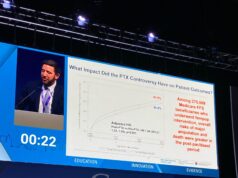“Until now, there has been no single document – no blueprint – defining interventional radiology that has had broad international support. It was time for interventional radiology to organise itself, worldwide, as a single family,” said James F Benenati, president of the Society of Interventional Radiology (SIR). SIR represents 4,500 US doctors, scientists and allied health professionals dedicated to improving health care through minimally invasive treatments.
Interventional radiologists offer the least invasive and most advanced treatment options for major health problems (including cancer, cardiovascular and venous disease, spine fractures, stroke and uterine fibroids), but many may not be aware of these advances. However, interventional radiology is not formally recognised as a “real” specialty or subspecialty in some countries. “Global Statement Defining Interventional Radiology” sets out to offer an universally accepted definition of the discipline, including details such as IRs’ expertise in diagnostic imaging and radiation safety, image-guided minimally invasive procedures and techniques as applied to multiple diseases and organs, the evaluation and management of patients suitable for the image-guided interventions included in the scope of IR practice and the continual invention and innovation of new techniques, devices and procedures. “When you have an inclusive, multinational document that represents more than 10,000 doctors worldwide, it is hard to deny their existence,” said Benenati, an interventional radiologist and medical director for the Noninvasive Vascular Laboratory at Baptist Cardiac & Vascular Institute in Miami, USA.
Work on the collaborative statement began two years ago by then SIR president John A Kaufman and his European counterpart, Jim A Reekers, then president of the Cardiovascular and Interventional Radiological Society of Europe (CIRSE).
“The goal is a document backed by interventional radiology societies all over the world stating, ‘This is what constitutes the specialty of interventional radiology,’” said Kaufman, professor at the Dotter Interventional Institute, Oregon Health & Science University, Portland, USA. “We expect that the document will be translated and published widely throughout the world.”













